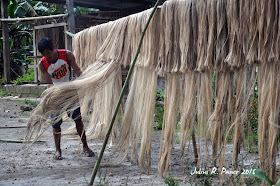Several good things graced me when I conducted my first LAWIN
Patrolling in Mt. Apo last January 7-8, 2017. Much as I do not want to be
pre-emptive about it but certainly there are changes hemming in the mountain
lately, including preliminary hint of biodiversity rebirth. Which to me should
be more than a reason to be jubilant as the New Year unfolded few days ago.
The LAWIN (Landscape and Wildlife Indicator) Monitoring System is a
tool introduced by the Department of Environment and Natural Resources (DENR) with
support from the BWISER-USAID in order to employ mechanism in assessing the biodiversity and
threats in protected areas, in our case the Mt. Apo Natural Park (MANP). The
LAWIN implementation is now handled by the Local Governments and private sector,
especially those with areas belonging to MANP. There will be series of Mt. Apo
patrolling using the cybertracker computer software. With the limitation of the
LGU’s manpower to handle patrolling we augmented volunteer personnel to do the
job by training them on LAWIN and eventually accredit them to assist the LGU in
biodiversity and threats patrolling. The output of which will be furnished to
DENR and other concerned offices for their information, reference and future
actions particularly in determining appropriate interventions to the findings. LAWIN
is also crucial in identifying whether there are significant changes that will
occur in the patrol areas in terms of the presence of indicator species and the
community’s awareness and responses to the threats identified.
Our trail in Sibulan has developed a greener backdrop. The single
track for climbers was covered with vegetation which had my group finding hard
time locating the trails especially in Basakan to Tinikaran campsite 1. It is
evident that the closure of Mt. Apo for trekking activity has paid off as it
gave enough time for the mountain to reinvigorate its natural characteristics.
As we trekked further up the Big Rock E-camp the forest in Sibulan
also becomes denser. With the heavy downpour sticking to us like a leech the
whole climb because of a Low Pressure Area, I noticed that the trail became
lightly unapproachable I had to deal with some trail detours. I also noted that
the campsites are healthier now, no trashes left, perhaps the result of the
simultaneous clean up drive conducted by PAMB Ecotourism Committee last July
2016. The water sources are full, especially in Tinikaran 2 which had not been
used in the last 5 years or so. My team used Tinikaran 2 as an overnight
stopover and although we only had 3 tents we still found it very hard to pitch them
because of the vegetation filling up the flat surface of the campsite.
It is remarkable also that the fauna population in Sibulan is surging
up. In the dead crater lake I saw presence of Apo Myna, while along the
forested areas I heard numerous sounds of hornbills, cockatoo, sunbirds and
perhaps woodpeckers (the one that sounds like knocking on a door?). And in a
specific site near Camp 1 we saw tracks of deer and wild boar. In the evening
of January 7 we heard a sound of a wild cat.
When I personally visited the areas affected by fire in the dead
crater walls, there are plant species starting to sprout, although the black
color as leftovers of the fire still prevails over the new ones. Over at the
peak campsite, according to my buddy Ronie Torlao there are few trashes left.
We have scheduled already with the porters to clear the trashes before the week
ends so that the summit would really be free or garbage right on time. There
are water sources available in the peak now, so as the entire dead Crater Lake.
Lastly, what I really missed about Mt. Apo is the Bagobo-Tagabawa
community in Colan and Tumpis who are all like brothers and sisters to me.
Their warm accommodation every single time I visit their place is a moment I
always treasure. My recent climb enabled me to hear their sentiments about
reopening Mt. Apo for mountaineering and trekking for economic reasons. The
store owners, habal-habal drivers and porters – they were all in affirmation
when I asked them if they are favourable to Mt. Apo’s reopening.
Whatever is the future of Mt. Apo mountaineering I leave it to the
wisdom of the Protected Area Management Board (PAMB). For 9 months after the
closure the community felt that the mountain had gave them so much in terms of
livelihood. Environmental consideration is always on top of everything I
supposed, and reopening Mt. Apo should always be associated with accountability
and responsibility among us stakeholders, aside from all these economic contemplation.
I am deeply gratified to have been given support
by the Ang Tribung Bagobo Woodlands Resort in Binaton, Digos City for providing
logistical support during my first patrolling in 2017. To the Abajero family
for being one with me in initiatives that underscore environmental
conservation. Thank you also to the patrol team who accompanied me all the way
to the summit in just two days. Special mention is due to volunteer patrollers
Ronnie Torlao, Jose Abajero, Maricar Abajero, Caprick Dean and Tessa Abajero.
And lastly, to the Office of the DENR Protected Area Superintendent for the
usual support and cooperation.
























